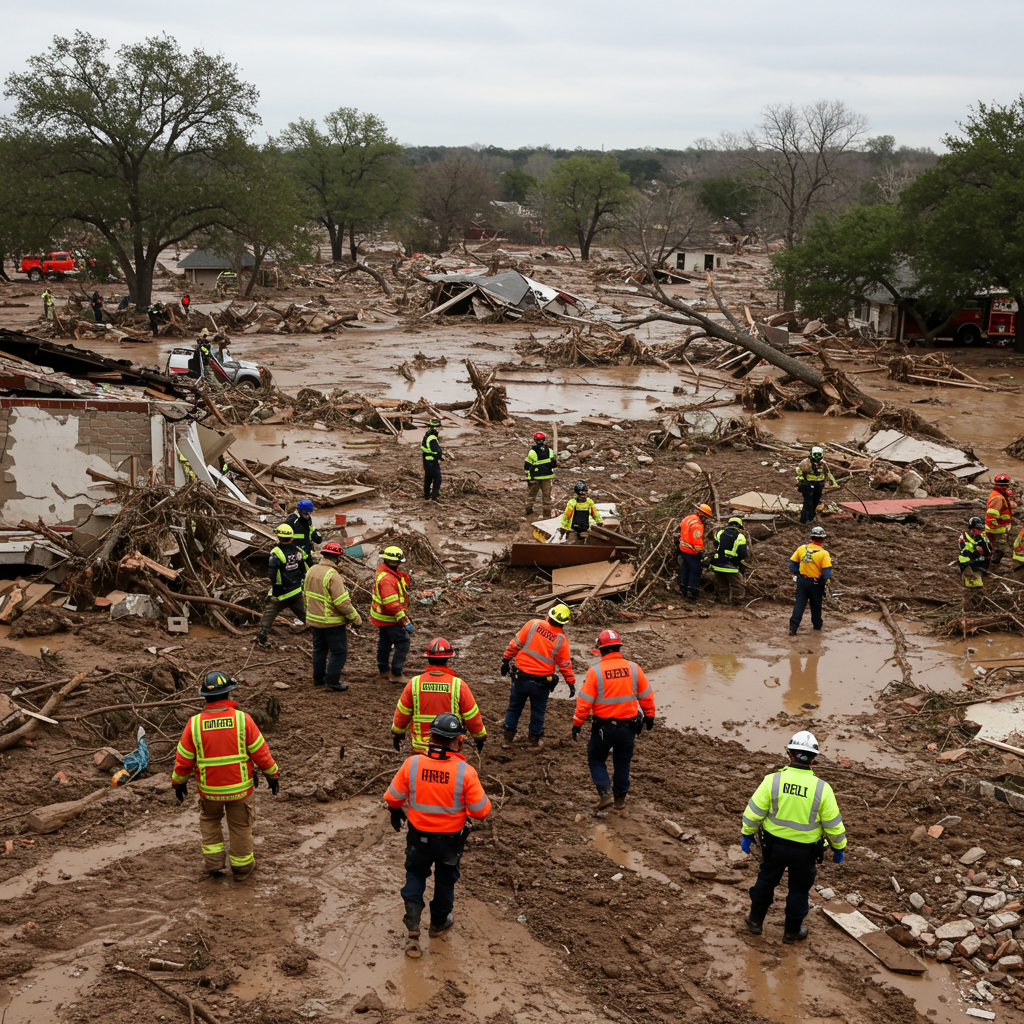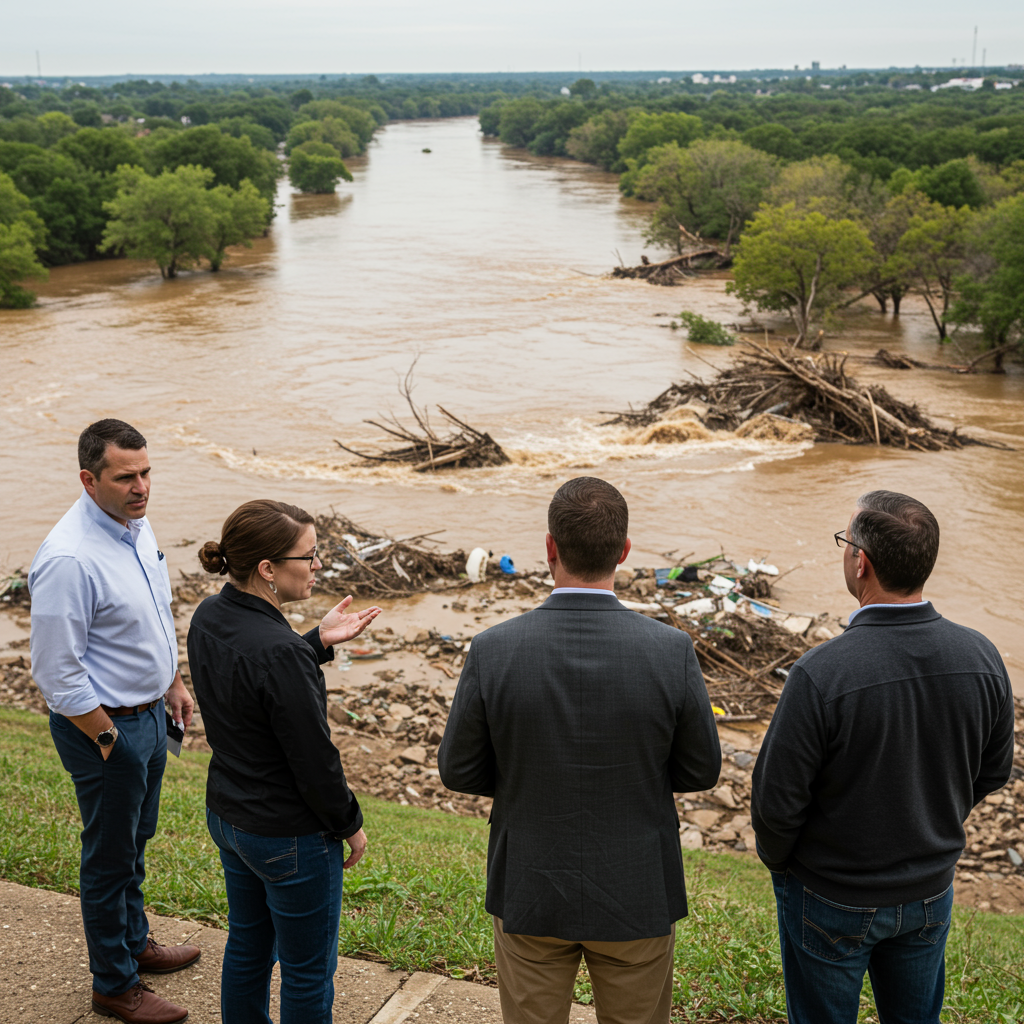A relentless search for survivors intensified in Texas Hill Country following a devastating flash flood that turned serene rivers into deadly torrents. The catastrophe, centered around Kerr county northwest of San Antonio, struck with terrifying speed, leaving behind a landscape of destruction and a heartbreaking toll. Emergency crews are working around the clock, driven by a solemn vow to find every person still unaccounted for.
The disaster unfolded late Thursday night into Friday morning when intense thunderstorms unleashed relentless rain across the region. The Guadalupe River, a cornerstone of the Hill Country landscape, rose dramatically, exceeding its banks and overwhelming communities situated along its path. Homes were swept away, vehicles submerged, and the sheer force of the water reshaped the riverbanks, leaving debris and mangled trees in its wake.
Catastrophic Flooding Sweeps Through Kerr County
The scale of the destruction quickly became apparent. At least 52 people perished in the flooding across the affected areas. Kerr County bore the brunt of the tragedy, reporting 43 deaths within its boundaries, including 28 adults and 15 children, according to Sheriff Larry Leitha. The suddenness of the event, coupled with the holiday weekend when many were gathered near the river, contributed significantly to the high number of casualties and missing persons.
The focus of the most urgent search efforts has been Camp Mystic, a Christian girls’ camp nestled along the Guadalupe River. The camp was hosting 700 girls when the flood hit. As floodwaters receded over the weekend, a harrowing reality emerged: 27 campers remained missing. The emotional anguish for waiting parents and families has been profound.
Devastation at Camp Mystic
Witness accounts painted a grim picture of the scene at Camp Mystic. Nick Sorter of the United Cajun Navy volunteer rescue group described the immense challenge, stating, “there was nowhere for these kids to go. The buildings were washed out, just carved out from the inside.” A 13-year-old survivor, Elinor Lester, recalled the camp being “completely destroyed,” the terrifying experience of helicopters arriving to rescue people, and the overwhelming fear.
The physical evidence at the camp underscored the ferocity of the flood. Photos revealed camp buildings reduced to rubble, bunkbeds caked in thick mud, and personal belongings like sheets, clothing, and suitcases jumbled chaotically. In some cases, entire walls were ripped from foundations. Tragically, some of the missing campers were confirmed among the deceased. News outlets reported the deaths of 8-year-old Sarah Marsh and 9-year-old Janie Hunt, highlighting the devastating impact on young lives. The nearby Heart O’ the Hills girls’ camp also reported a fatality, co-owner Jane Ragsdale, although that camp was not in session, and all others there were accounted for. Camp Mystic, beloved by generations of Texas families who cherished its peaceful setting along the river, now stood as a symbol of the disaster.
The Unrelenting Search Continues
Rescue crews have mounted an intensive, round-the-clock operation, scouring miles of riverbanks littered with debris. They have successfully pulled stranded individuals from rooftops and found survivors clinging to trees and other structures. Kerr County Sheriff Larry Leitha emphasized the unwavering commitment of rescuers, stating, “We will not stop until every single person is found.”
The sheer number of people affected is staggering. Kerrville City Manager Dalton Rice reported that “hundreds” of individuals have been rescued or evacuated from the flood zone. However, determining the precise number of missing people remains a significant challenge. Rice noted the distinction between the “known missing,” like the 27 campers from Camp Mystic, and others whose whereabouts are unknown. Texas Lieutenant Governor Dan Patrick estimated up to 500 rescue workers were involved in the search. The difficulty in accounting for everyone stems partly from the timing of the flood, coinciding with the Independence Day holiday. Many people were likely in the area for celebrations, staying in tents, small trailers, or rented homes along the riverbanks, making a definitive count difficult.
Accounts From the Floodwaters
Witnesses described the sudden and terrifying nature of the flood. Tonia Fucci, visiting her grandmother nearby, woke to the sound of incredibly heavy rain and “loud, startling cracking noises.” These turned out to be massive cypress trees along the river being torn down by the force of the water. Fucci filmed the torrent of muddy water inundating the road. She noted the crucial role of residents who immediately began helping neighbors before formal rescue teams could arrive. Fucci received National Weather Service alerts hours after the flood had already struck, highlighting the unprecedented speed of the event. The sight of “debris and furniture and RVs coming down the river” underscored the unimaginable power of the water.
Understanding the Cause of the Catastrophe
Texas Hill Country is notoriously susceptible to flash flooding, earning the nickname “flash flood alley.” The region’s rugged, rolling terrain and shallow soil contribute to this vulnerability. When heavy rains occur, the water cannot soak into the ground quickly; instead, it rushes rapidly down hillsides, concentrating in streams and rivers. This geographical characteristic creates ideal conditions for suddenly developing, severe floods.
The Independence Day flood was triggered by intense thunderstorms that delivered extraordinary rainfall. Kerr County received as much as 15 inches of rain – half of its typical annual total – in just a few hours. Across the wider region, up to 16 inches fell between July 3rd and 5th. This immense volume of water pouring into the river system led to an unprecedented rise in the Guadalupe River. Weather reports indicated the river surged more than 26 feet in a mere 45 minutes, a speed and scale rarely seen. Experts, like recently retired NOAA storm specialist Alan Gerard, described the scenario as “horrifying,” emphasizing how several factors converged in a vulnerable location to create the disaster. While the Guadalupe River has a history of flooding, this event ranks among the worst.
Warnings and Preparedness Challenges
The extreme flooding struck before dawn with minimal specific, localized warning, according to Kerrville City Manager Dalton Rice. This rapid onset made it difficult for authorities to issue timely evacuation orders for those immediately in harm’s way. State emergency management officials had issued general warnings about heavy rains and flash flood threats for west and central Texas in the days leading up to the holiday weekend, based on National Weather Service forecasts. However, W. Nim Kidd, director of the Texas Division of Emergency Management, acknowledged that these forecasts “did not predict the amount of rain that we saw.”
Conflicting perspectives on the adequacy of warnings emerged. Some reports suggested that general forecasts should have provided enough time for officials to evacuate vulnerable sites. Kerr County Judge Rob Kelly noted that previous discussions about a flood siren system, similar to tornado warnings, had not materialized due to cost and the belief that “nobody saw this coming” at such a scale. Former NOAA director Rick Spinrad highlighted that shortfalls in preparing for such extreme storms would inevitably lead to more casualties and property damage.
Impact Beyond Kerr County
While Kerr County was the epicenter of the tragedy, the devastation extended to other parts of Texas. Approximately 150 miles away, the community of San Angelo and surrounding Tom Green County experienced record-breaking rainfall, with 14 inches reported. This triggered severe flooding there as well. San Angelo police tragically discovered the body of Tanya Burwick, 62, after her SUV was engulfed in 12 feet of water. Her death underscored the widespread nature of the flood’s impact. Other counties, including Travis, Burnet, and Kendall, also reported fatalities linked to the floodwaters.
The days following the initial surge have been filled with intense rescue efforts and a somber search for the missing. Rescuers face challenging conditions, navigating debris-strewn areas. Concerns also lingered about potential further rainfall exacerbating conditions in the saturated region.
Frequently Asked Questions
How did the Guadalupe River flood so quickly and severely?
The Guadalupe River’s rapid and severe flooding was caused by a combination of factors common to Texas Hill Country, known as “flash flood alley.” Intense thunderstorms delivered extraordinary amounts of rain in a very short period – up to 15 inches in Kerr County, which is half its annual total. The region’s geography, with rugged slopes and shallow soil, prevents rain from soaking in. Instead, the water rushes rapidly downhill into rivers, causing them to swell dramatically and almost instantly. This event saw the river rise an unprecedented 26 feet in just 45 minutes.
Where were the most severe impacts of the Texas flood concentrated?
The most severe impacts of the Texas flood were primarily concentrated in Kerr County, located about 85 miles northwest of San Antonio. The areas along the Guadalupe River near Hunt and Ingram experienced the worst of the devastation. Camp Mystic, a Christian girls’ camp on the river’s edge in Kerr County, was severely damaged and was the location of many missing persons. While Kerr County had the highest death toll, significant flooding and fatalities also occurred approximately 150 miles away in San Angelo, Tom Green County, and other nearby areas including Travis, Burnet, and Kendall counties.
What is the current status of the search for missing persons from the Texas flood?
As of the days following the flood, rescue crews were conducting an intensive, around-the-clock search for missing persons, particularly focused along the Guadalupe River in Kerr County. Sheriff Larry Leitha vowed that the search would continue until everyone was found. While hundreds of people were rescued or evacuated, the total number of missing remained uncertain. Authorities confirmed 27 missing campers from Camp Mystic but noted that many others who were in the area for the holiday weekend, potentially in temporary accommodations, were also unaccounted for, making a definitive count challenging. Search efforts continued despite the difficulties posed by debris and the widespread nature of the disaster.
The Texas Hill Country community faces a long and difficult road to recovery. The immediate focus remains on finding the missing, supporting rescue crews, and providing aid to the hundreds displaced by the floodwaters. The tragic events of the Independence Day weekend serve as a stark reminder of the power of nature and the vulnerabilities posed by sudden, extreme weather events in the region’s unique geography. The resilience of responders and residents helping one another provides a glimmer of hope amidst the profound loss.
Word Count Check: ~1100 words



